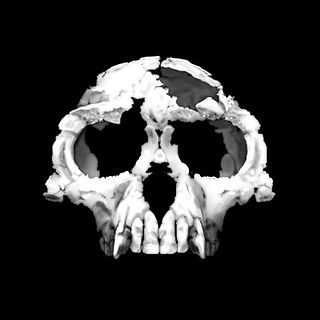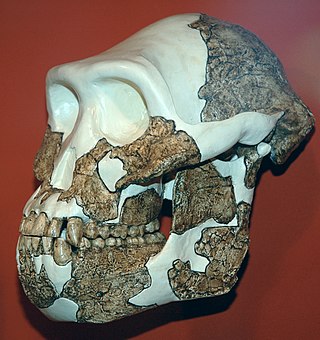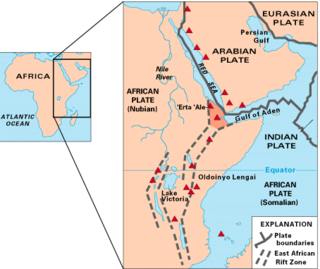Further reading
- J.E. Kalb, E.B. Oswald, A. Mebrate, S. Tebedge and C. Jolly, Stratigraphy of the Awash Group, Middle Awash Valley, Afar, Ethiopia, Newsletters on Stratigraphy11 (1982), pp. 95–127.
The Dikika is an area of the Afar Region of Ethiopia. A hominin fossil named Selam, a specimen of the Australopithecus afarensis species, was found in this area. Papers also propose the earliest evidence of stone tool use at this site in the form of cut marks on animal bone. [1] However there has been argument about this proposal. [2] [3] [4] Dikika is located in Mille woreda. [5]
Dikika is also given to name a basal member of the Hadar formation, a series of sedimentary rocks deposited approximately 3.4 million years ago, which have been exposed by the erosive action of the Awash River. Although sometimes called "Lucy's Child" Dikika was in fact older than Lucy or Dinknesh at 3.4 million years.

Ardipithecus is a genus of an extinct hominine that lived during the Late Miocene and Early Pliocene epochs in the Afar Depression, Ethiopia. Originally described as one of the earliest ancestors of humans after they diverged from the chimpanzees, the relation of this genus to human ancestors and whether it is a hominin is now a matter of debate. Two fossil species are described in the literature: A. ramidus, which lived about 4.4 million years ago during the early Pliocene, and A. kadabba, dated to approximately 5.6 million years ago. Initial behavioral analysis indicated that Ardipithecus could be very similar to chimpanzees, however more recent analysis based on canine size and lack of canine sexual dimorphism indicates that Ardipithecus was characterised by reduced aggression, and that they more closely resemble bonobos.

Homo habilis is an extinct species of archaic human from the Early Pleistocene of East and South Africa about 2.31 million years ago to 1.65 million years ago (mya). Upon species description in 1964, H. habilis was highly contested, with many researchers recommending it be synonymised with Australopithecus africanus, the only other early hominin known at the time, but H. habilis received more recognition as time went on and more relevant discoveries were made. By the 1980s, H. habilis was proposed to have been a human ancestor, directly evolving into Homo erectus which directly led to modern humans. This viewpoint is now debated. Several specimens with insecure species identification were assigned to H. habilis, leading to arguments for splitting, namely into "H. rudolfensis" and "H. gautengensis" of which only the former has received wide support.

Australopithecus is a genus of early hominins that existed in Africa during the Pliocene and Early Pleistocene. The genera Homo, Paranthropus, and Kenyanthropus evolved from some Australopithecus species. Australopithecus is a member of the subtribe Australopithecina, which sometimes also includes Ardipithecus, though the term "australopithecine" is sometimes used to refer only to members of Australopithecus. Species include A. garhi, A. africanus, A. sediba, A. afarensis, A. anamensis, A. bahrelghazali and A. deyiremeda. Debate exists as to whether some Australopithecus species should be reclassified into new genera, or if Paranthropus and Kenyanthropus are synonymous with Australopithecus, in part because of the taxonomic inconsistency.
A stone tool is, in the most general sense, any tool made either partially or entirely out of stone. Although stone tool-dependent societies and cultures still exist today, most stone tools are associated with prehistoric cultures that have become extinct. Archaeologists often study such prehistoric societies, and refer to the study of stone tools as lithic analysis. Ethnoarchaeology has been a valuable research field in order to further the understanding and cultural implications of stone tool use and manufacture.

Australopithecus afarensis is an extinct species of australopithecine which lived from about 3.9–2.9 million years ago (mya) in the Pliocene of East Africa. The first fossils were discovered in the 1930s, but major fossil finds would not take place until the 1970s. From 1972 to 1977, the International Afar Research Expedition—led by anthropologists Maurice Taieb, Donald Johanson and Yves Coppens—unearthed several hundreds of hominin specimens in Hadar, Ethiopia, the most significant being the exceedingly well-preserved skeleton AL 288-1 ("Lucy") and the site AL 333. Beginning in 1974, Mary Leakey led an expedition into Laetoli, Tanzania, and notably recovered fossil trackways. In 1978, the species was first described, but this was followed by arguments for splitting the wealth of specimens into different species given the wide range of variation which had been attributed to sexual dimorphism. A. afarensis probably descended from A. anamensis and is hypothesised to have given rise to Homo, though the latter is debated.
Hadar or Hadar Formation is a paleontological fossil site located in Mille district, Administrative Zone 1 of the Afar Region, Ethiopia, 15 km upstream (west) of the A1 road's bridge across the Awash River.

Australopithecus anamensis is a hominin species that lived approximately between 4.2 and 3.8 million years ago and is the oldest known Australopithecus species, living during the Plio-Pleistocene era.

The Afar Triangle is a geological depression caused by the Afar Triple Junction, which is part of the Great Rift Valley in East Africa. The region has disclosed fossil specimens of the very earliest hominins; that is, the earliest of the human clade, and it is thought by some paleontologists to be the cradle of the evolution of humans. The Depression overlaps the borders of Eritrea, Djibouti and the entire Afar Region of Ethiopia; and it contains the lowest point in Africa, Lake Assal, Djibouti, at 155 m (509 ft) below sea level.

Australopithecus garhi is a species of australopithecine from the Bouri Formation in the Afar Region of Ethiopia 2.6–2.5 million years ago (mya) during the Early Pleistocene. The first remains were described in 1999 based on several skeletal elements uncovered in the three years preceding. A. garhi was originally considered to have been a direct ancestor to Homo and the human line, but is now thought to have been an offshoot. Like other australopithecines, A. garhi had a brain volume of 450 cc (27 cu in); a jaw which jutted out (prognathism); relatively large molars and premolars; adaptations for both walking on two legs (bipedalism) and grasping while climbing (arboreality); and it is possible that, though unclear if, males were larger than females. One individual, presumed female based on size, may have been 140 cm tall.

The Afar Region, formerly known as Region 2, is a regional state in northeastern Ethiopia and the homeland of the Afar people. Its capital is the planned city of Semera, which lies on the paved Awash–Assab highway. It’s bordered by Eritrea to the north and Djibouti to the northeast; it also shares regional borders with the Tigray, Amhara, Oromo and Somali regions.

AL 288-1, commonly known as Lucy or Dinkinesh, is a collection of several hundred pieces of fossilized bone representing 40 percent of a female of the hominin species Australopithecus afarensis. It was discovered in 1974 in Ethiopia, at Hadar, a site in the Awash Valley of the Afar Triangle, by paleoanthropologist Donald Johanson of the Cleveland Museum of Natural History.

Selam (DIK-1/1) is the fossilized skull and other skeletal remains of a three-year-old Australopithecus afarensis female hominin, whose bones were first found in Dikika, Ethiopia in 2000 and recovered over the following years. Although she has often been nicknamed Lucy's baby, the specimen has been dated at 3.3 million years ago, approximately 120,000 years older than "Lucy".

Zeresenay "Zeray" Alemseged is an paleoanthropologist who is a faculty member at the University of Chicago. In 2013, he was named a Fellow of the American Association for the Advancement of Science. He was elected to the American Academy of Arts & Sciences in 2021. In 2022, he was appointed to the Comité Scientifique International du Musée d’Anthropologie Préhistorique de Monaco and the Pontifical Academy of Science. Alemseged is best known for his discovery, on 10 December 2000, of Selam, also referred to as the "Dikika child" or “Lucy’s child”, the almost-complete fossilized remains of a 3.3 million-year-old child of the species Australopithecus afarensis. The “world’s oldest child”, she is the most complete skeleton of a human ancestor discovered to date. Selam represents a milestone in understanding of human and pre-human evolution and contributes significantly to understanding of the biology and childhood of early species in the human lineage; a subject about which we have very little information. Alemseged discovered Selam while working with the Dikika Research Project (DRP), a multi-national research project funded in part by the National Science Foundation, which he both initiated in 1999 and leads. The DRP has thus far made many important paleoanthropological discoveries and returns to the field each year to conduct further important research. Alemseged's specific research centers on the discovery and interpretation of hominin fossil remains and their environments, with emphasis on fieldwork designed to acquire new data on early hominin skeletal biology, environmental context, and behavior.
Ceratotherium mauritanicum is a species of fossil African rhinoceros found in the Late Pliocene to earliest Holocene of Morocco, Tunisia, and Algeria. Slightly older fossils from the Pliocene of eastern Africa were also proposed to belong to this species, but it has been considered to belong to a somewhat more primitive species, Ceratotherium efficax. A 2020 study considers C. efficax to be the same species as C. mauritanicum, however.

The Shungura Formation is a stratigraphic formation located in the Omo river basin in Ethiopia. It dates to the Late Pliocene to Early Pleistocene. Oldowan tools have been found in the formation, suggesting early use of stone tools by hominins. Among many others, fossils of Panthera were found in Member G of the formation.

The greater Turkana Basin in East Africa determines a large endorheic basin, a drainage basin with no outflow centered around the north-southwards directed Gregory Rift system in Kenya and southern Ethiopia. The deepest point of the basin is the endorheic Lake Turkana, a brackish soda lake with a very high ecological productivity in the Gregory Rift.
Damalborea is an extinct genus of alcelaphine bovid. It was first named by Alan W. Gentry in 2010, and the type species is Damalborea elisabethae. It is known from the holotype AL 208–7, a skull with horn cores collected from the Middle Pliocene Hadar Formation Member SH-3 of Ethiopia. In addition, a fossils of this or a closely related species were collected from Aramis, Wee-ee and Maka localities in the Middle Awash deposits, lower and upper units of the Laetolil Beds, as well as Tulu Bor Member and an unknown horizon of the Koobi Fora Formation. Geraads, Bobe & Reed (2012) assigned all Damalborea specimens from the Basal Member and Sidi Hakoma member of the Hadar Formation to the species D. elisabethae; in addition, the authors named the second species, Damalborea grayi, described on the basis of fossils from the Denen Dora member of the Hadar Formation. Damalborea was a moderately large alcelaphine with high and narrow skull proportions.

Lomekwi 3 is the name of an archaeological site in Kenya where ancient stone tools have been discovered dating to 3.3 million years ago, which make them the oldest ever found.

Enhydriodon is an extinct genus of mustelids known from Africa, Pakistan, and India that lived from the late Miocene to the early Pleistocene. It contains 9 confirmed species, 2 debated species, and at least a few other undescribed species from Africa. The genus belongs to the tribe Enhydriodontini in the otter subfamily Lutrinae. Enhydriodon means “otter tooth” in Ancient Greek and is a reference to its dentition rather than to the Enhydra genus, which includes the modern sea otter and its two prehistoric relatives.
Gona is a paleoanthropological research area in Ethiopia's Afar Region. Gona is primarily known for its archaeological sites and discoveries of hominin fossils from the Late Miocene, Early Pliocene and Early Pleistocene. Fossils of Ardipithecus and Homo erectus were discovered there. Two of the most significant finds are an Ardipithecus ramidus postcranial skeleton and an essentially complete Homo erectus pelvis. Historically, Gona had the oldest documented Oldowan artifact assemblages. Archaeologists have since found older examples of the Oldowan at other sites. Still, Gona's Oldowan assemblages have been essential to the archaeological understanding of the Oldowan. Gona's Acheulean archaeological sites have helped us understand the beginnings of the Acheulean Industry.